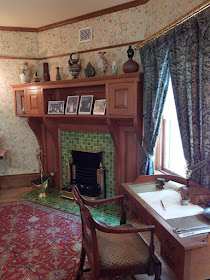When the
Glessners’ corner guestroom was opened to the public in April 2014 after a four
year restoration project, one important element was missing – the Morris &
Co. “Double Bough” wallpaper. Thanks to
the generosity of numerous donors, we raised the necessary funds to replicate
the wallpaper which was installed in late June, allowing us to reopen the room
earlier this month.
The fundraising
campaign was led by a generous $10,000 grant from the National Society
Daughters of the American Revolution (NSDAR), which was sponsored by the
Chicago Chapter, the first local DAR chapter organized in the United States. Frances Glessner was a charter member of the
Chicago Chapter when it was formed in 1891, and the chapter has funded several
recent projects at the museum, including the installation of the exhibit on The
Rocks, and the restoration of the Glessners’ Kutani bowl.
Corner guestroom in 1923 (top) and 2015 (below)
The Glessners
first installed Double Bough in the guestroom in 1892 after the room had been
wired for electricity. When the room was
re-wallpapered in 1916, they chose Double Bough once again. In November 2010, during early work in the
restoration project, Robert Furhoff, an expert in historic interiors and
finishes, uncovered a section of the original wallpaper which was carefully peeled
off the wall and conserved. The fragment
was important as it established the color way selected by the Glessners. Morris & Co. produced the wallpaper in
several different color ways, and of course, the only surviving historic images
of the room were in black and white.
Robert Furhoff, November 2010
The Morris &
Co. archive in England was consulted, and a small sample was found in one of
the company log books that matched the sample from the Glessner bedroom. The museum was also informed that all 22
original hand-carved fruitwood blocks used to print the original paper were in
the archive, and could be used again to reprint the wallpaper using exactly the
same process as undertaken more than 120 years ago.
Sample from the Morris & Co. archives
In order to produce
the wallpaper in this manner, the process is extremely time consuming as each
of the 22 blocks is applied individually and then the paper needs to dry
sufficiently before the next block can be applied. As such, only one roll of wallpaper can be
produced per week.
The order was
placed in May 2014 with Zoffany, the parent company of Sanderson, which owns
the Morris & Co. archives. Several
weeks later, the first strike-off was received for approval. Robert Furhoff was again brought in for
consultation, and several corrections were made to the colors used in various
parts of the design. The corrections
were returned to England and a second strike-off was received, which was
approved. Production began and the 25
rolls of wallpaper were shipped to the museum in December.
Wallpaper awaiting installation
Due to the way
in which the wallpaper is produced, the installation is a complex process, as
absolutely no water or paste can ever touch the surface of the paper, or the
ink can be damaged. The museum was
fortunate to secure the services of Jim Yates of Historic Wallpaper
Specialties, who has a national reputation for the installation of 19th
century wallpapers. One of his most
prominent projects was the wallpaper in the Lincoln Bedroom at the White House.
Jim Yates
In late June,
Yates and his team arrived at the museum from Tennessee, and spent the next six
days completing the project. Their work
began with the installation of muslin on the walls, so that in the event any
cracking of the plaster occurs, it will transfer to the muslin itself, and not
damage the wallpaper. Once the muslin
was installed, it was covered with an acid-free liner to provide the optimum
base to which the wallpaper would be applied.
While these
steps were being undertaken, the wallpaper was all cut to size and readied for
installation. Only one historic photo survives
showing the first installation of the wallpaper from 1892.
Fanny Glessner, November 24, 1897
This photo was taken of Fanny Glessner on the
day of her formal debut – November 24, 1897.
The photo was studied to ensure that the pattern (a 31” repeat) was
placed on the walls exactly as it had been originally – both top to bottom, and
side to side.
As the wallpaper
was placed on the walls, the room took on an entirely different feel, as the space
was suddenly filled with the intricate floral design that is among the most
complex ever produced by Morris & Co.
Within a few days, the
furnishings were brought back into the room, including the Morris & Co. “Rose and Thistle” reproduction draperies,
Morris inspired area rug, furniture designed by A. H. Davenport & Company,
and engravings displayed in custom-made frames by Isaac Scott.
Corner guestroom in 1923 (top) and 2015 (below)
The room was
reopened to the public for tours on Wednesday July 1, 2015. With the completion of this room, Glessner
House Museum now features one of the largest public collections of Morris & Co.
reproduction wallpapers, textiles, and rugs in the country, accurately
recreating the Arts and Crafts inspired interior created by John and Frances
Glessner more than a century ago.










No comments:
Post a Comment